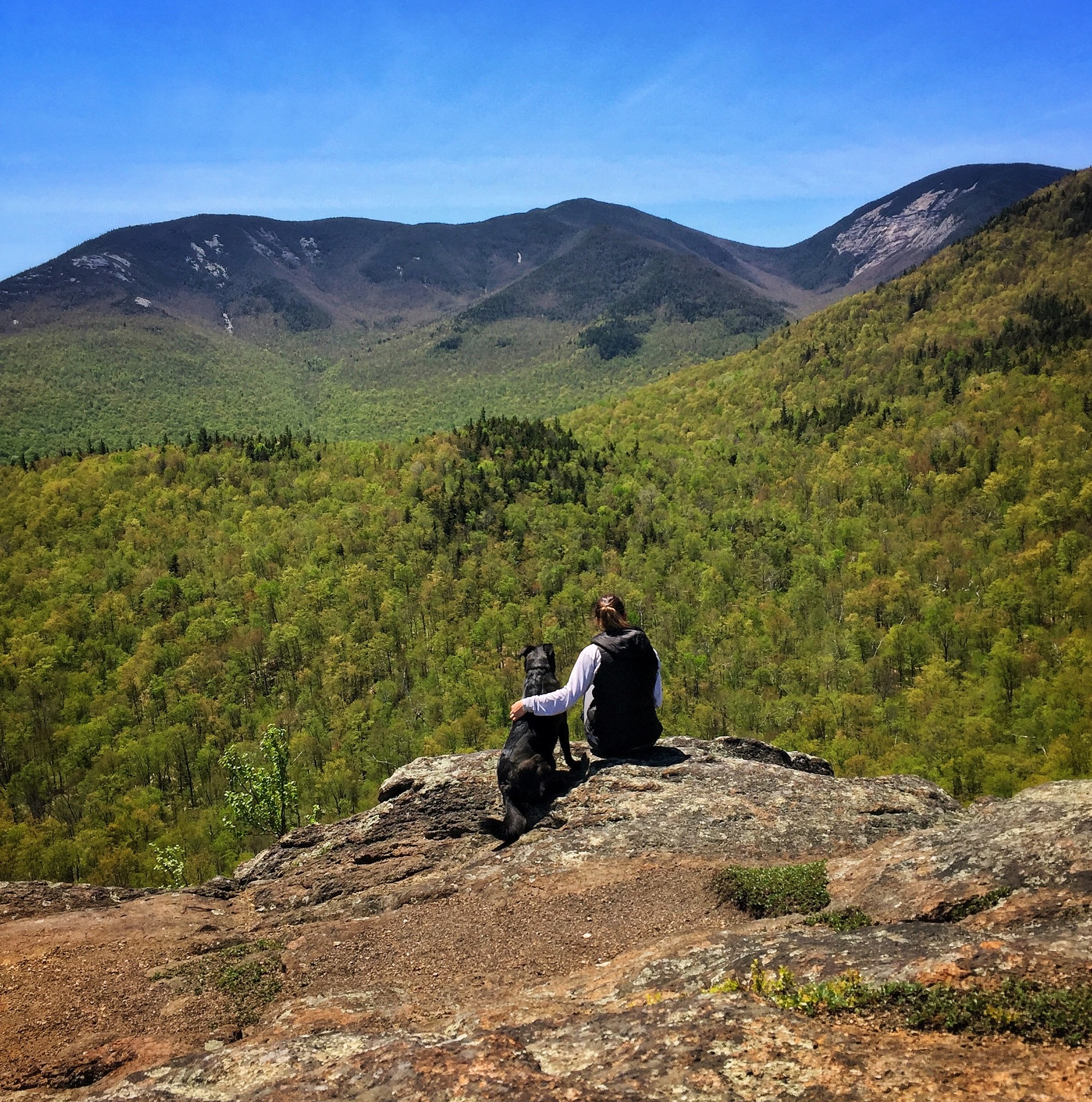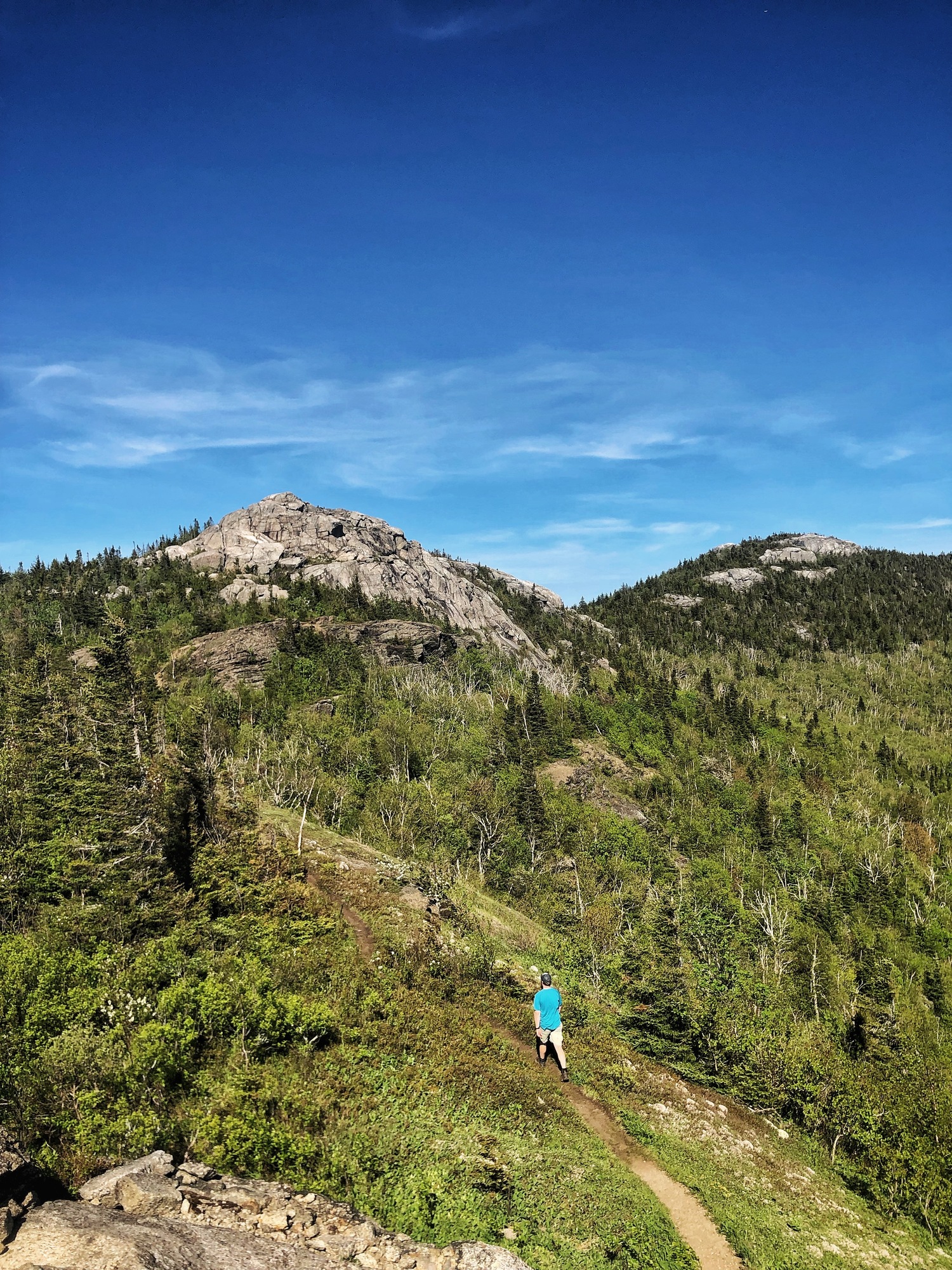|
Have a safe and enjoyable outdoor recreational experience on the lands and waters of the Adirondacks. Properly plan and prepare for your outdoor adventure. Minimize the impact on the mountains and forests, rivers and brooks, ponds and lakes, and the wildlife of the Adirondacks.
Check the Backcountry Information for the Adirondacks web pages for more detailed information on access, outdoor recreation infrastructure, and conditions for those planning to recreate in the Adirondacks. This bulletin provides only the most recent notices.
Emergency Situations: If you get lost or injured; keep calm and stay put. If you have cell service, call 911 or the DEC Forest Ranger Emergency Dispatch, 518-891-0235.
Check mountain weather conditions before heading out this weekend.
Packing the proper gear for a hike is very important, and you should be prepared to encounter all conditions. See our recommended packing list and safety tips.
Bear Advisory: While preparing for your camping or hiking trip, check area notices for active bear advisories. If there are active bears present where you are planning to go, either choose an alternative trip or thoroughly educate yourself on how to reduce your chance of a bear encounter with proper food storage, disposal of food waste, and then what to do if you happen to encounter a bear. Learn more about avoiding nuisance bears.
Plan Ahead and Prepare
Weather forecasts and conditions can and do change quickly. Check the current National Weather Service Forecast, and be prepared for the forecasted conditions or change your plans.
-
Summer is officially here! The 21st marks the longest day of the year, but this doesn’t mean hikers should ditch the headlamps. Darkness sets in a lot quicker in the forest, and while hikers should make the most of the long hours of daylight, they should always be
 prepared. Here are a few summer preparedness tips to remember before hitting the trail: prepared. Here are a few summer preparedness tips to remember before hitting the trail:
- Rest and hydrate often to help combat heat exhaustion.
- Apply sunscreen and Chapstick with SPF liberally and often.
- Bring plenty of food to keep up with the calories being burned.
- Keep an eye and ear on the weather. Summer heat can bring unexpected thunderstorms in the mountains.
-
Black flies: Yes, the black flies are still out in force. Wear clothing that fully covers your body, use bug spray where you are not protected, and bring/wear a bug net to protect yourself from black flies. Wear light-colored clothing. Flies are attracted to dark colors.
-
Wet and muddy trails: Continuous rainy weather has kept trails from drying out. Trails, especially higher elevation summits, are still very wet and muddy creating slippery and unstable conditions on steeper sloping trails. Wear durable, waterproof hiking boots and bring trekking poles for extra stability while hiking through the mud. Think about postponing your high peak hike until trails have dried.
-
Parking restrictions along Route 73: Reminder that parking is prohibited on the shoulders along State Route 73. Violators will be ticketed. Park in designated pull offs and parking areas only. Choose one of these hikes under 2,500ft instead.
Practice Leave No Trace
 Follow proper trail etiquette to maintain minimal impact on the environment and the natural resources of the Adirondacks as well as ensure an enjoyable outdoor experience for all visitors by following the Seven Principles of Leave No Trace. Follow proper trail etiquette to maintain minimal impact on the environment and the natural resources of the Adirondacks as well as ensure an enjoyable outdoor experience for all visitors by following the Seven Principles of Leave No Trace.
Summer is a great time for getting outdoors but it also means an influx of people on the trails and summits. Be considerate of other visitors and enjoy your experience by following these tips for handling busy weekends on the trails:
-
Have patience! It’s easy to forget that when faced with a crowd of people on the trail or on a summit that you are also part of the crowd. Remember that everyone is out to enjoy their own personal experience and journey in the wilderness. Show kindness and support for those you may pass along the way. Share the views at the summit and overlooks so everyone has a chance to soak in the beauty, and keep noise levels to a minimum.
-
Get up earlier! The earlier you rise, the fewer people will be on the trail. Parking is easier to find and you will find yourself alone or among the few other early risers at your destination.
-
Explore areas that are less popular! Research and keep a bank of less traveled and less popular trails and areas. Explore them when there are times of high use in the highly popular places. Some of the best destinations and views are found on the trails less known.
General Conditions/Notices
Learn the conditions you will encounter from Adirondack Backcountry Information
All
-
Travel: Check NY511 for road closures and conditions.
-
Spring Weather: Temperatures are warming and there are more sunny days than not, but it continues to be cooler and wetter than usual.
- Water levels are higher and water temperatures are colder than is typical for this time of year.
- Paddlers and tubers should be aware of these conditions.
- Air temperatures can be warm, while water temperatures remain cold.
- Mud and water present on seasonal access roads and trails.
- Check spring recreation tips for a safe and enjoyable outing while minimizing impacts on natural resources and trails.
- Check the National Weather Service or NY Mesonow for current conditions and forecasts for the location where you plan to recreate.
-
Seasonal Access Roads: Most seasonal access roads are open while a few remain closed for mud season.
- Seasonal access roads are dirt and gravel which can be rough.
- Four-wheel drive SUVs, pick-up trucks, and other high clearance vehicles are recommended for driving on these roads.
- Roads may be narrow – use caution, drive slowly, and watch for oncoming vehicles.
-
Biting Insects: It is “Bug Season” in the Adirondacks. Black flies and mosquitoes are present in large numbers. Follow these steps to minimize the nuisance of biting insects:
- Wear light colored long sleeve shirts and long pants.

- Tuck shirts into pants, button or rubber band sleeves at the wrist, and tuck the bottom of pant legs into your socks.
- Pack a head net to wear when insects are thick.
- Use an insect repellant with DEET. Follow label directions.
-
Fire Danger: Low, throughout the Adirondacks. Check the Fire Danger Rating Map
-
Thunderstorm Safety: Thunderstorms can pop up even if they are not forecast.
- Avoid summits, water surfaces and other open areas during thunderstorms.
- As soon as you are first aware of an approaching thunderstorm, move to lower elevations, head to shore or otherwise seek shelter.
- If caught outside in a thunderstorm, find a low spot away from tall trees, seek an area of shorter trees and crouch down away from tree trunks.
-
Report Moose Sightings:
- DEC is asking the public to report moose sightings and observations.
- DEC and its research partners use these public sightings as indices of moose distribution and abundance in New York.
- This is part of a multi-year research project to obtain information on the status of New York State's moose population, health of the moose, and the factors that influence moose survival and reproductive rate.
- Use the moose sighting form.
Hikers & Campers
-
General Information:
-
Muddy Trail Advisory: Due to cool temperatures and the amount of rainfall, the Muddy Trail Advisory remains in effect.
- Please protect high elevation trails and vegetation and postpone hikes on trails above 2,500 feet until these high elevation trails have dried and hardened.
- Snow and ice are currently melting on high elevation trails.
- Steep trails with thin soils can be dangerous to hike and are susceptible to erosion. Sensitive alpine vegetation is easily damaged.
- Choose any of the numerous trails under 2,500 feet to hike until the advisory is lifted.
-
Trail Conditions:
- Mud and water are present on most trails – protect trails and trailside vegetation by walking through mud and water, not around it.
- Water levels are high - low water crossings may be problematic or impossible to cross.
-
Bear Resistant Canisters:
- The use of bear-resistant canisters is required for overnight users in the Eastern High Peaks Wilderness between April 1 and November 30.
- All food, toiletries and garbage must be stored in bear-resistant canisters.
- DEC encourages the use of bear-resistant canisters and other practices to avoid negative encounters with bears throughout the Adirondacks.
-
Mountain Summits: Please avoid high elevation mountain summits while the Muddy Trail Advisory is in effect.
Bikers
-
General Information: Biking
-
Trail Conditions:

- Most trails are dry and rideable, but some trails remain closed due to wet and muddy conditions.
- Don’t use muddy trails. They are easily rutted and damaged through use.
- If you are leaving tracks, turn back.
- The Barkeaters Trail Alliance provides information on the status of mountain bike trails in the Tri-lakes region of the Adirondacks.
-
E-bikes: Electric powered bikes are prohibited on all bike trails on the Forest Preserve.
Boaters, Paddlers, and Anglers
-
General Information
-
Conditions
- Water levels are higher and water temperatures are colder than usual for this time of year.
- Paddlers, tubers, and waders should expect to encounter strong currents on rivers.
- A group of paddlers on the Batten Kill in Washington were unable to avoid a tree that had fallen in the river (aka a strainer) due to the strong currents.
- DEC strongly recommends all anglers, boaters and paddlers wear Personal Flotation Devices (PFDs aka lifejackets).
- People immersed in cold waters can lose the ability to think clearly and move quickly after only a short time in the water.
- Check the USGS Current Water Data for New York for stream flow of selected waters.
-
DEC Boat Launches: Docks have been installed at all but a few boat launches where high water levels are preventing installation.
Climbers
Recent Notices
Notices below reflect recent changes in conditions and recreation infrastructure work completed by DEC and its partners. Check the Adirondack Backcountry Information web pages for ongoing issues and more detailed information.
-
Saranac Lake Wild Forest: The Saranac River is closed to boating between the Lower Locks and Second Pond Boat Launch because of extremely low waters levels.
- The low water levels are a result of vandals breaking into the controls for the sluice gate overnight and fully opening it.
- The sluice gate was further damaged and cannot be immediately closed. DEC is working to repair and close the gate.
- DEC will provide notice when repairs are complete and water levels have risen. Anybody with information regarding the vandalism should call 518-897-1326.
-
Speculator Tree Farm Conservation Easement Tract: All seasonal access roads are open to public motor vehicle use.
-
Boreas Ponds Tract: Work on the Gulf Brook Road has been delayed.
- During the next few weeks Gulf Brook Road will be open seven days a week to the Fly Pond Parking Area.
- DEC will provide notice here when the work starts, and the road will be open on Saturdays and Sundays only.
-
Sable Highlands Conservation Easement Tract:
- The logging operation is complete, and the D&H Road is once again open to public motor vehicle use.
-
Moose River Plains Wild Forest:
- All seasonal access roads, except for Rock Dam Road, are open to public motor vehicle use.
- As part of a repaving project on Route 28 between Inlet and Blue Mountain Lake, the Department of Transportation contractors are reconstructing the entrance driveway and the large parking area that serves both the Rocky Mountain and Bear Mountain Trailheads and is the site of an Aquatic Invasive Species Boat Check Station. The parking lot will be closed while this work takes place but should reopen Friday, 6/21.
-
Blue Mountain Wild Forest/Township 19 & 20 Conservation Easement Tracts:
- Pickwickett Pond Road is open to public motor vehicle use.
- The following roads remain closed to public motor vehicle use.
- Minerva Club Road
- O'Neil Flow Road
- Barker Pond Road
-
Kushaqua Conservation Easement Tract: Mountain Pond Road remains closed due to muddy conditions.
-
Vanderwhacker Wild Forest: Wolf Pond Trail and the Wolf Pond Lean-to are open to public use.
- The 2.3-mile Wolf Pond Trail is accessible from Boreas River/Wolf Pond Parking Area on the Blue Ridge Road near the bridge over the Boreas River.
- The gently rolling and easy to navigate trail crosses Wolf Pond Brook and proceeds northeast.
- The trail ends at the outlet of Wolf Pond, and the new lean-to is located up a short spur trail on the south-western side of the pond.
- Wolf Pond provides scenic views of the High Peaks and surrounding mountains as well as excellent fishing opportunities.
- The 59-acre pond is home to stocked wild strain brook trout.
-
Aldrich Pond Wild Forest: All seasonal access roads, including Streeter Lake Road, are open to public motor vehicle access.
-
Perkins Clearing Conservation Easement Tract: All seasonal access roads are now open to public motor vehicle use.
-
High Peaks Wilderness: Hikers seeking to use the Mt. Van Hoevenberg East Trail,
 which opened last fall, will be re-routed around the construction underway to make significant improvements to Olympic Sports Complex facilities. which opened last fall, will be re-routed around the construction underway to make significant improvements to Olympic Sports Complex facilities.
- Hikers can park at the Biathlon Facility parking area in the Complex and use a marked 2.9-mile detour bypassing the construction zone using roads, ski trails, and a temporary trail to reach the Mt. Van Hoevenberg East Trail approximately 1.0 mile below the summit.
- Expect to encounter trail workers along the trail to the summit of the mountain as they complete the final touches on the sustainably designed and recently opened trail.
- Hikers may also reach the summit using the traditional route – the 2.2-mile Mt. Van Hoevenberg West Trail which begins at the trailhead on Meadows Lane.
-
Ausable Mountain Reserve Conservation Easement Tract/High Peaks & Giant Mountain Wildernesses:
-
Parking is prohibited on a four-mile section of State Route 73 between Chapel Pond and the Rooster Comb Trailhead.
- Officers have and will continue to issue tickets for vehicles parked in no parking zones.
- Tickets can result in fines up to $250 plus court costs.
- Parking will still be allowed at trailheads and other designated pull-offs.
- DEC encourages hikers to discover and visit the other numerous hiking opportunities in the area, or visit on weekdays when there is less demand.
-
Hikes Outside the Adirondack High Peaks lists a dozen nearby alternate hikes.
Highlighted Hike: Wanika Falls, Lake Placid, NY
Wanika Falls via the Northville-Placid Trail is a 13.9-mile (RT) moderately trafficked out and back trail.
The trail begins at the Northville-Placid trailhead located on Averyville Road in Lake Placid, NY. The trail gains a total of 1,400 feet in elevation over the nearly 7-mile hike in to the falls. Wanika Falls is a 150-foot cascading waterfall that is made up of several large sections and significant drops. Hikers should be prepared with plenty of water, sturdy boots, bug spray, a headlamp, and a map of the route.
Northville-Placid Trail/Wanika Falls trailhead: You can reach this via the Averyville Road, 1.2 miles south of its intersection with Old Military Road, the terminus of the 133-mile trail. Parking is on the left just before Averyville Road crosses the Chubb River.
|


 prepared. Here are a few summer preparedness tips to remember before hitting the trail:
prepared. Here are a few summer preparedness tips to remember before hitting the trail:
 Follow proper trail etiquette to maintain minimal impact on the environment and the natural resources of the Adirondacks as well as ensure an enjoyable outdoor experience for all visitors by following the
Follow proper trail etiquette to maintain minimal impact on the environment and the natural resources of the Adirondacks as well as ensure an enjoyable outdoor experience for all visitors by following the 

 which opened last fall, will be re-routed around the construction underway to make significant improvements to Olympic Sports Complex facilities.
which opened last fall, will be re-routed around the construction underway to make significant improvements to Olympic Sports Complex facilities.